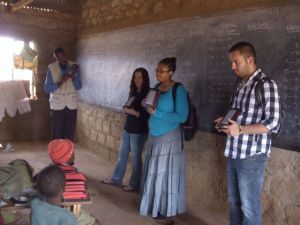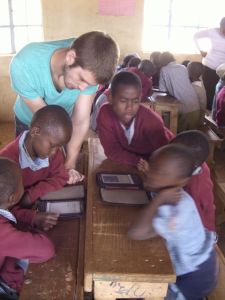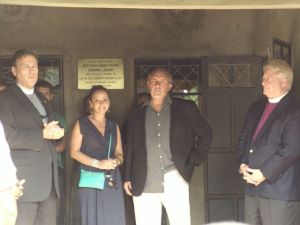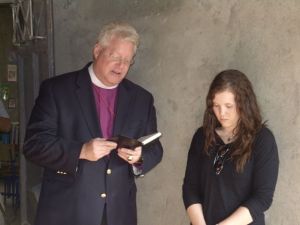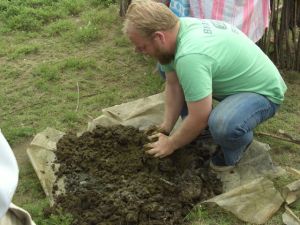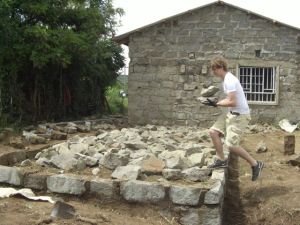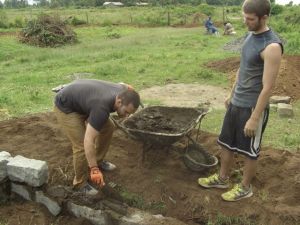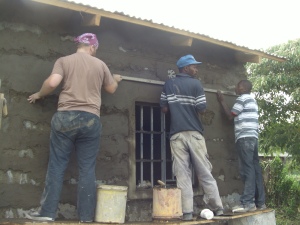I’m writing this blog from the passenger seat of a safari van on its way south from Nakuru, Kenya. The whole College Team is present and we are a relaxed and very happy bunch. We’ll be taking of from Kenyatta airport in about thirteen hours on our 24 hour combination of flights back to Kansas City International Airport. The trip is almost done and we’re ready to return. Only the intrepid Tyler Kerr will be staying behind, for two more weeks to work on a water filtration project with the Community and Medical Teams.

Lake Nakuru is famous for its large flamingo population.

There are zebra all over the place. This one has a baby!

We got to see a spectacular rain storm blow in. “It’s gonna take a lot to take me away from you!”
For the past 24 hours, we’ve been on Safari in and around the Lake Nakuru Game Reserve, located near the town of Nakuru, Kenya. Nakuru is the capital of the county were we’ve been spending most of our time. Nakuru is also the see of the Anglican Diocese of Nakuru (I asked Joe, our driver for the past two weeks, if he knew where the cathedral of Nakuru was and he said he didn’t. Should have thought of that much earlier!).

We saw a lot of buffalo. This one was especially old and unflappable.
Modern-day safaris aren’t anything like the kind that Dr. Livingston would have taken into the bush. Today, due to the conservation efforts of the Kenyan government, safaris are pretty clinical. You pay an entry fee ($80) to get into a game reserve (think “huge park with a TON of animals bound by a fence, but not from each other”) and then you go on a drive along gravel roads looking at animals in their “natural” habitat. Then you buy a room at a five-star resort inside the Park. It’s actually pretty amazing and it can be very random, but it’s not the “Go Out Into The Bush With Your Elephant Gun and Pith Hat” of yester-year. In 2007 when I was here, we safaried at Samburu game reserve up in North Kenya.

We saw many giraffe. This one was especially beautiful.
As I have been sitting in the front seat for the entirety of our time in Kenya, I’ve had a lot of conversations with Joe who is a very wise man. He has an insane amount of experience driving around Kenya and makes his living driving foreigners into and around game reserves. I was especially blown away by his knowledge of the animals of Kenya’s game parks. He told me that Nakurua is good for viewing Flamingo, but that we wouldn’t see any elephants. I was especially sad to hear this as seeing live elephant troops in Samburu was one of the highlights of my last trip to Kenya… it literally moved me to tears. I do remember being disappointed at not being able to see the other big herbivores: Rhinoceros and Hippopotamus.

A solitary white rhino. Very large.
We arrived in Lake Nakuru Park around 10:30am on Thursday and went for our first drive on our way to our Lodge and our awaiting lunch. On the way in, we saw several different kinds of gazelle (learning the difference between the Grant Gazelle and the Thompson Gazelle: The white coloring on the butt starts above the tail in the Thompson Gazelle), a TON of Buffalo, a family of Varvet Monkeys and some baboons. Joe told me that Kenyans call baboons “naughty boys.” I asked why and he said, “They like to steal food and if they can’t find food, they shit in your things.”

A baboon in its most non-threatening stance. This is a buddha baboon.
So we were feeling pretty good when we got to our first stop, a lookout over the massive Lake Nakuru called Baboon Point. Now I will tell you that when I was in Samburu in 2007, the one rule was “Don’t get out of the vehicle.” Well that apparently isn’t a rule in Nakuru because Joe parked and told us that we could go to the lookout if we liked. We all left the vehicle and spent about ten minutes enjoying the spectacular view and using the restroom. Just as we were getting back into the vehicle, we saw a male baboon walking through the parking lot. One of the ladies asked if they were dangerous and, as if wanting to answer for itself, the baboon turned and started walking toward our vehicle. When it picked up speed and started running, we heard several cries of, “Uh Oh!” In one bounce, it used my window as a vaulting point to jump up onto the roof of the bus and entered the van (which was occupied by the full team. As it jumped around inside, the team left the van faster than rats flee a sinking ship. Joe and I jumped out of the vehicle as well and everybody was screaming.
After making just a few moments, the baboon escaped out the top of the van carrying a plastic back of water and snacks. Joe successfully scared it away by throwing rocks and a walking stick at it. Thinking we were safe, we all started to get back into the van after having a good laugh, but just as we re-entered the van, the baboon, who was disappointed to have only found a bottle of water in the bag returned and entered the van again. More screaming and laughing ensued and the baboon made off with a can of Red Bull. We all piled into the van and took off.
Joe says that nothing like that has ever happened to him before. As the adrenaline wore off, we just kept laughing and laughing about the baboon and imagined what would happen if he did actually drink that Red Bull (a popular energy drink). We started joking around about how we were all experiencing PBTSD (Post-Baboon Traumatic Stress Disorder) and every baboon we saw for the rest of the safari was a potential assailant. Later on that evening, we imagined that the baboons might mount a war party to come get the rest of our Red Bull.

We only saw one hyena. This one is a spotted hyena.
That experience could easily have gone very badly. Like all apes, the Baboon is incredibly strong for its size (this one was about the size of an average American 9th grader). They also have very sharp fangs to help their omnivorous diet. Thankfully, nobody was bitten or scratched and the only damage was to our sense of invincibility and to one of the young ladies’ cameras.

Egyptian Geese abound in Nakuru. We were pumped to see all the goslings!
My high point of the safari was the chance to see rhinoceros. We were able to see several of the more abundant white rhinos including several young rhinos. However, the real treat was seeing three different black rhinos, rarest of the rhino species. I believe there are less than 2,000 black rhinos still alive; both species have been hunted to the brink for their horns, which are thought, in some parts of the world, to cure everything from erectile dysfunction to cancer. Seeing lions and cheetahs is cool, but for me seeing the endangered massive herbivores is a huge treat.
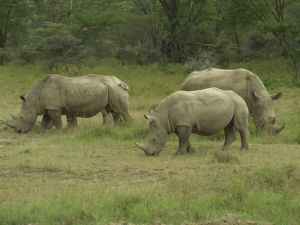
A family of white rhinoceros. Two adolescents!

All my black rhino pictures look like pictures of Bigfoot or the Loch Ness Monster. This was the best. Notice a much bigger horn and darker color.
The rest of the safari was pretty uneventful, but we enjoyed our Sabbath at the resort and our delicious meals. In 2007, I was deeply troubled by the expense we put into a post-Mission safari, especially imagining what good that kind of money could do in the troubled places of Kenya. This time around I’m still troubled by it, but also consider it as an important part of getting the “African Experience,” something we might never again be able to do. Seeing the animals that we’ve only read about or seen in pictures is an amazing treat. We still do have to contend with the disconnect between the poverty we see in Kibera and Maai Mahiu, but we also have to take opportunities to experience the majesty of God’s creation.
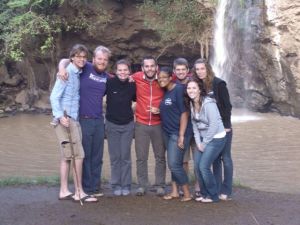
The full team at Malika Falls.
Finding balance is very difficult. Prayer helps. Humility is important. God’s love through our sinfulness endures.
lost in wonder, love, and praise...




















